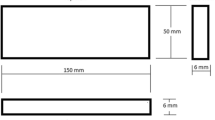Abstract
Material removal rate, shear force and variance of shear force during copper polishing are studied as a function of pad conditioning scheme: 0% in situ conditioning (i.e., basically the equivalent of ex situ conditioning) and fractional in situ conditioning variants (i.e., conditioning during the first 25, 50, 75 or 100% of the total polish time). Spectral analysis of raw shear force data is employed to help elucidate the fundamental physical phenomena during copper chemical mechanical planarization. Fast Fourier transform is performed to convert the shear force data from time domain into frequency domain. The energy distribution of copper polishing is quantified which sheds light on the effect of fractional in situ pad conditioning. Variance of shear force and spectral analysis indicate that pad micro-texture evolution ceases after 50% fractional conditioning, thereby indicating that in situ conditioning time can be reduced during a given polishing process thus extending pad life. This study shows that a combination of unique spectral fingerprinting and analysis of force variance can be used to monitor the effect of pad conditioning in real time. This work also underscores the importance of real-time detection and non-destructive method to extend pad life and consumable usage during CMP by optimizing the pad conditioning time.



Similar content being viewed by others
References
Stein, D., Hetherington, D., Dugger, M., Stout, T.: Optical interferometry for surface measurements of CMP pads. J. Electron. Mater. 25, 1623–1627 (1996)
Stavreva, Z., Zeidler, D., Plötner, M., Drescher, K.: Characteristics in chemical-mechanical polishing of copper: comparison of polishing pads. Appl. Surf. Sci. 108, 39–44 (1997)
Byrne, G., Mullany, B., Young, P.: The effect of pad wear on the chemical mechanical polishing of silicon wafers. CIRP Ann. Manuf. Technol. 48, 143–146 (1999)
Yamada, Y., Kawakubo, M., Kadomura, K., Sugaya, T., Hirai, O., Tsugane, K.: Experimental analysis of pad wear response effect on removal rate variations in tungsten chemical mechanical polishing. J. Electrochem. Soc. 157, H617–H623 (2010)
Shi, H., Ring, T.A.: CMP pad wear and polish-rate decay modeled by asperity population balance with fluid effect. Microelectron. Eng. 87, 2368–2375 (2010)
Park, K., Oh, J., Jeong, H.: Pad characterization and experimental analysis of pad wear effect on material removal uniformity in chemical mechanical polishing. Jpn. J. Appl. Phys. 47, 7812–7817 (2008)
Miyauchi, H.: CMP pad surface characterization for CMP mechanism investigation. In: Proceedings of 13th International Symposium on Chemical Mechanical Planarization, Lake Placid (2008)
Borucki, L.: Mathematical modeling of polish-rate decay in chemical-mechanical polishing. J. Eng. Math. 43, 105–114 (2002)
Chang, O., Kim, H., Park, K., Park, B., Seo, H., Jeong, H.: Mathematical modeling of CMP conditioning process. Microelectron. Eng. 84, 577–583 (2007)
Matsumura, Y., Hirao, T., Kinoshita, M.: Analysis of pad surface roughness on copper chemical mechanical planarization. Jpn. J. Appl. Phys. 47, 2083–2086 (2008)
Han, R., Sampurno, Y., Philipossian, A.: Feasibility of a real-time method in determine the extent of pad break-in during copper chemical mechanical planarization. Tribol. Lett. 62, 1–6 (2016)
http://techcet.com/wpcontent/uploads/2014/10/TECHCETCMPUGBerninFranceR2rev1101014BRoberts.pdf
Philipossian, A., Mitchell, E.: Dispersion number studies in CMP of interlayer dielectric films. J. Electrochem. Soc. 150, G854–G860 (2003)
Philipossian, A., Olsen, S.: Fundamental tribological and removal rate studies of inter-layer dielectric chemical mechanical planarization. Jpn. J. Appl. Phys. 42, 6371–6379 (2003)
Sampurno, Y., Sudargho, F., Zhuang, Y., Goldstein, M., Philipossian, A.: Feasibility of real-time detection of abnormality in inter layer dielectric slurry during chemical mechanical planarization using frictional analysis. Thin Solid Films 516, 7667–7674 (2008)
Mu, Y., Jiao, Y., Sampurno, Y., Zhuang, Y., Theng, S., Philipossian, A.: Effect of temperature in titanium chemical mechanical planarization. J. Appl. Phys. 54, 076502 (2015)
Jiao, Y., Sampurno, Y.A., Zhuang, Y., Wei, X., Meled, A., Philipossian, A.: Tribological, thermal, and kinetic characterization of 300-mm copper chemical mechanical planarization process. J. Appl. Phys. 50, 05EC02 (2011)
Bracewell, R.: The Fourier Transform and Its Applications. McGraw-Hill, New York (1994)
Brigham, E., Oran, H.: The Fast Fourier Transform and Its Applications. Prentice-Hall, Inglewood Cliffs (1988)
Nagayama, K., Morishita, H., Kimura, K., Tanaka, K., Khajornrungruang, P., Inatsu, Y.: A Computational Study on Slurry Flow Between a Wafer and CMP Pad With Grooves. Towards Synthesis of Micro-/Nano-systems, pp. 277–280. Springer, London (2007)
Rosales-Yeomans, D., DeNardis, D., Borucki, L., Suzuki, T., Philipossian, A.: Analysis of pads with slanted grooves for copper CMP. J. Electrochem. Soc. 155, H750–H763 (2008)
Author information
Authors and Affiliations
Corresponding author
Rights and permissions
About this article
Cite this article
Han, R., Sampurno, Y. & Philipossian, A. Fractional In Situ Pad Conditioning in Chemical Mechanical Planarization. Tribol Lett 65, 21 (2017). https://doi.org/10.1007/s11249-016-0803-7
Received:
Accepted:
Published:
DOI: https://doi.org/10.1007/s11249-016-0803-7




